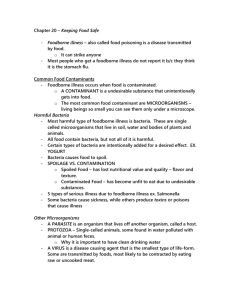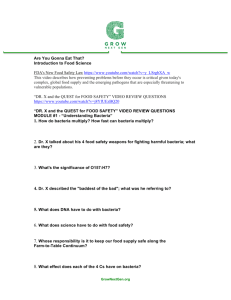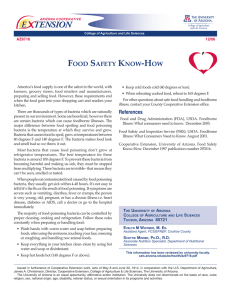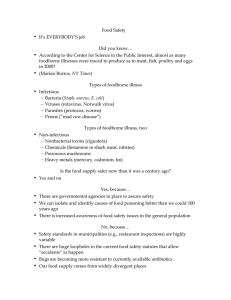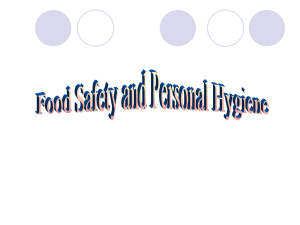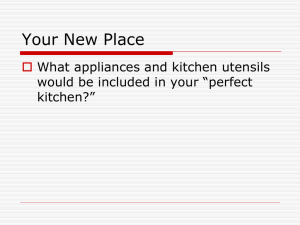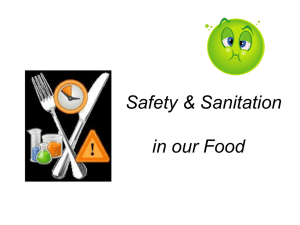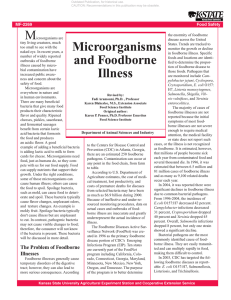Food Safety Review
advertisement
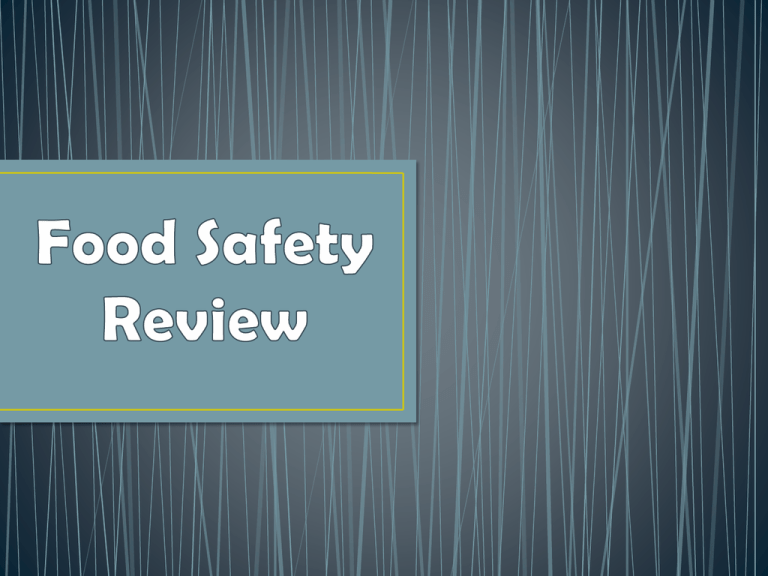
• AKA: Foodborne Disease or Food Poisoning • Infection or intoxication cause by substances that spoil or infect from food or drinking water to humans. • In most cases the contaminants are bacteria, parasites or viruses. • Any microorganism that is infectious or toxigenic and causes disease • Parasites • Viruses • Some fungi/yeast • Bacteria • Any substance that is added to food and affects the food’s characteristics • Preservatives • Sweeteners • Flavorings • Artificial and natural colorings • Nutritional Supplements • An incident in which TWO or more cases of a similar illness result from eating the same food. • A poison that is produced by microorganisms, carried by fish, or released by plants • Any group who may be more susceptible to more serious symptoms or side effects from an illness than the general population. At-risk groups for foodborne illness include Very young children Pregnant woman Elderly People with weakened immune systems Symbol • A process in which ionizing energy is used to kill pathogens and other harmful substances in food by causing breaks in the DNA • The process of using heat or irradiation to destroy microorganisms that could cause disease. • Louis Pasteur (1822-1895) • Chemist who invented pasteurization • Was actually trying to prevent spoilage in wine and beer when he discovered pasteurization. • Pasteurization was first applied in wine preservation. • When milk producers introduced pasteurization it substantially reduced foodborne illness. • Bacteria are very heat sensitive • The higher the temp the quicker they are inactivated Using higher heat takes less time to kill pathogenic bacteria Using lower heat takes more time to kill pathogenic bacteria • Method for killing harmful bacteria in foods that contain water • Destroys bacteria without the use of high temperatures or chemical additives. Can grow within 10-12 Hours • Bacterium which are found naturally around us, including those that cause foodborne illnesses. • The transfer of bacteria from foods, hands, utensils, or food preparation surfaces to a food. Particularly a problem with Liquids from RAW Meats Poultry Seafood • Harmful bacteria can be transmitted to previously uncontaminated foods or surfaces • • • • • Food Drugs Medical Devices Vaccines, blood, biologics Animal & Veterinary Drugs • Cosmetics • Radiation-Emitting Products • Tobacco Products “Protecting and promoting your health” Clean Cook Combat Chill http://www.usda.gov/wps/portal/usda/usdahome • Is found on perishable food products in stores • Do not purchase that product after the “Sell By” date • The correct way to thaw foods is to… Take the Food from the freezer place in the refrigerator to thaw. • When you thaw foods in the microwave they must be consumed/eaten immediately . • DO NOT THAW FOODS IN THE SINK • When going on a picnic remember that ALL PERISHABLE FOODS should be kept on ICE • Refrigerator’s temperature should be 40 degrees or below • Freezer’s temperature should be 0 degrees or below • Left overs should ALWAYS be put into the refrigerator • If you are not sure if a food is still safe to eat ALWAYS remember…. “When in doubt, throw it out” • Using a food thermometer is the ONLY way to check and see if eggs and meats are properly cooked. • The proper internal temperature of ground meat is… 160 degrees • Uncooked meats should be stored away from fresh produce • Do not buy canned foods that have dents, cracks, rust or bulging lids. • You should have two cutting boards in your kitchen… one for meats one for fruits & vegetables



